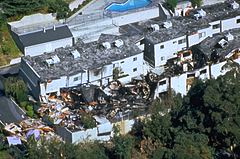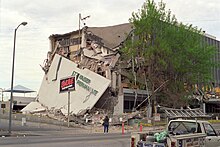1994 Northridge Earthquake

Northridge Earthquake: 1994 News Coverage
At 4:30 am, on January 17, 1994, the San Fernando Valley area of southern California was rocked by a strong M6.7 quake. It was centered beneath the city of Northridge, California. Here’s a compilation of actual news coverage including southern California stations such as KNBC, KCAL, and KABC.
Building collapsed as a result of the earthquake

The Northridge earthquake occurred on January 17, 1994, at 04:31 a.m. Pacific Standard Time and was centered in Reseda, a neighborhood in the north-central San Fernando Valley region of Los Angeles, California. It had a duration of approximately 10–20 seconds. The earthquake had a “strong”moment magnitude (Mw) of 6.7, but the ground acceleration was one of the highest ever instrumentally recorded in an urban area in North America, measuring 1.8g (16.7 m/s2) with strong ground motion felt as far away as Las Vegas, Nevada, about 220 miles (360 km) from the epicenter. The peak ground velocity in this earthquake at the Rinaldi Receiving station was 183 cm/s (4.09 mph or 6.59 km/h), the fastest peak ground velocity ever recorded. In addition, two 6.0 Mw aftershocks occurred, the first about one minute after the initial event and the second approximately 11 hours later, the strongest of several thousand aftershocks in all.[7] The death toll was 57, with more than 5,000 injured. In addition, earthquake-caused property damage was estimated to be more than $20 billion, making it one of the costliest natural disasters in U.S. history.
Epicenter

The earthquake struck in the San Fernando Valley about 20 miles (31 km) northwest of downtown Los Angeles. Although given the name “Northridge”, the epicenter was located in the community of Reseda; it took several days to pinpoint the epicenter in detail.
The National Geophysical Data Center placed the hypocenter’s geographical coordinates at 34°12′47″N 118°32′13″W and at a depth of 11.4 miles (18.3 km). This locates the epicenter between Arminta St. and Ingomar St. just west of Reseda Blvd. The earthquake occurred on a previously undiscovered fault, now named the Northridge blind thrust fault (also known as the Pico thrust fault). Several other faults experienced minor rupture during the main shock and other ruptures occurred during large aftershocks, or triggered slip earthquakes.
Damage and Fatalities
I-10 skyway after earthquake. Note that the collapsed section is near where the supporter beam is.
Damage occurred up to 85 miles (125 km) away, with the most damage in the west San Fernando Valley, and the cities of Santa Monica, Simi Valley and Santa Clarita. The exact number of fatalities is unknown, with sources estimating it at 60 or “over 60,” to 72, where most estimates fall around 60. The “official” death toll was placed at 57; 33 people died immediately or within a few days from injuries sustained in the earthquake, and many died from indirect causes, such as stress-induced cardiac events. Some counts factor in related events such as a man’s suicide possibly inspired by the loss of his business in the disaster.
M
More than 8,700 were injured including 1,600 who required hospitalization. The Northridge Meadows apartment complex was one of the well-known affected areas in which sixteen people were killed as a result of the building’s collapse. The Northridge Fashion Center and California State University, Northridge also sustained very heavy damage—most notably, the collapse of parking structures. The earthquake also gained worldwide attention because of damage to the vast freeway network, which serves millions of commuters every day. The most notable of this damage was to the Santa Monica Freeway, Interstate 10, known as the busiest freeway in the United States, congesting nearby surface roads for three months while the freeway was repaired. Farther north, the Newhall Pass interchange of Interstate 5 (the Golden State Freeway) and State Route 14 (the Antelope Valley Freeway) collapsed as it had 23 years earlier in the 1971 Sylmar earthquake even though it had been rebuilt with improved structural components. One life was lost in the Newhall Pass interchange collapse: LAPD motorcycle officer Clarence Wayne Dean fell 40 feet from the damaged connector from southbound 14 to southbound I-5 along with his motorcycle. Because of the early morning darkness, he did not realize that the elevated roadway below him had collapsed, and was unable to stop in time to miss the fall and died instantly. When the interchange was rebuilt again one year later, it was renamed the Clarence Wayne Dean Memorial Interchange in his honor.
A
Additional damage occurred about 50 miles (80 km) southeast in Anaheim as the scoreboard at Anaheim Stadium collapsed onto several hundred seats. The stadium was vacant at the time. Although several commercial buildings also collapsed, loss of life was minimized because of the early morning hour of the quake, and because it also occurred on a federal holiday (Martin Luther King, Jr. Day). Also, because of known seismic activity in California, area building codesdictate that buildings incorporate structural design intended to withstand earthquakes. However, the damage caused by the earthquake revealed that some structural specifications did not perform as intended. Because of these revelations, building codes were revised. Some structures were not red-tagged until months after the earthquake, because damage was not immediately evident.
The quake produced unusually strong ground accelerations in the range of 1.0 g. Damage was also caused by fire and landslides. The Northridge earthquake was notable for hitting almost the same exact area as the MW 6.6 San Fernando (Sylmar) Earthquake. Some estimates of total damage range as high as $25 billion.
Most casualties and damage occurred in multi-story wood frame buildings (e.g. the three-story Northridge Meadows apartment building). In particular, buildings with an unstable first floor (such as those with parking areas on the bottom) performed poorly. Numerous fires were also caused by broken gas lines from houses shifting off their foundations or unsecured water heaters tumbling. In the San Fernando Valley, several underground gas and water lines were severed, resulting in some streets experiencing simultaneous fires and floods. Damage to the system resulted in water pressure dropping to zero in some areas; this predictably affected success in fighting subsequent fires. Five days after the earthquake it was estimated that between 40,000 and 60,000 customers were still without public water service. As is typical in earthquakes, unreinforced masonry buildings and houses on steep slopes suffered damage. However, school buildings (K-12), which are required by California law to be reinforced against earthquakes, in general survived fairly well.
Valley Fever Outbreak
An unusual effect of the Northridge earthquake was an outbreak of coccidioidomycosis (Valley fever), a respiratory disease caused by inhaling airborne spores of a species of fungus unique to the American southwest. The number of cases (203) in Ventura County was roughly 10 times the normal rate in the eight weeks following the earthquake and three people died. This was the first report of such an outbreak following an earthquake and it is believed that the spores were carried in large clouds of dust created by seismically triggered landslides. Most of the cases occurred immediately downwind of the landslides.
Hospitals Affected
Eleven hospitals suffered structural damage and were damaged or unusable after the earthquake. Not only were they unable to serve their local neighborhoods, they also had to transfer out their inpatient populations, which further increased the burden on nearby hospitals that were still operational. As a result, the state legislature passed a law requiring all hospitals in California to ensure that their acute care units and emergency rooms would be in earthquake-resistant buildings by January 1, 2005. Most were unable to meet that deadline and only managed to achieve compliance in 2008 or 2009.
Television, movie, and music productions affected
The earthquake disrupted production of movies and TV shows filming in the area at the time. The Star Trek: Deep Space Nine episode “Profit and Loss” was being filmed at the time, and actors Armin Shimerman and Edward Wiley left the Paramount Pictures lot in full Ferengi and Cardassian makeup respectively. The season five episode of Seinfeld entitled “The Pie” was due to begin shooting on the day of the earthquake before stage sets were damaged. NBC’s The Tonight Show, hosted by Jay Leno, took place in the NBC Studios in Burbank, close to the epicenter of the quake. Also, ABC’s General Hospital, which shoots in Los Angeles, was heavily affected by the Northridge earthquake. The set, which is at ABC Television Center, suffered major damage including partial structural collapse and water damage.
All of the earthquake sequences in the Wes Craven film New Nightmare were filmed a month prior to the Northridge quake. The real quake struck only weeks before filming was completed. Subsequently, a team was sent out to film footage of the quake damaged areas of the city. The cast and crew had initially thought that the scenes that were filmed before the real quake struck were a bit overdone, but when viewed after the real quake hit, they were horrified by the realism of it.
Michael Jackson had been due to begin recording of his new album HIStory on the day of the earthquake, but Jackson’s entourage moved recording to New York City. They returned to the studio in Los Angeles some six months later.
Some archives of film and entertainment programming were also affected. For example, the original 35 mm master films for the 1960s sitcom My Living Doll were destroyed in the earthquake.
On September 9, 1995, Animaniacs produced a segment parodying the quake to start their third season (global episode number 70) in a sketch called “A Quake, a Quake!”







